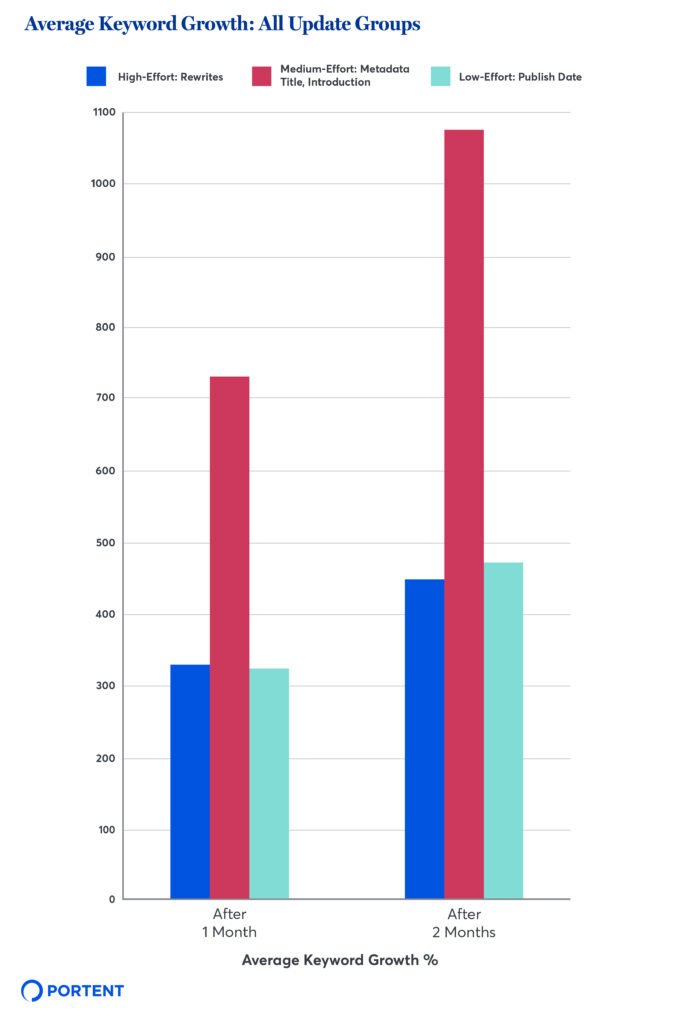The benefits of refreshing or rewriting old blog posts to breathe new life into a website are well-established and include more traffic, new backlinks, and improved keyword rankings.
Consequently, content recycling is among the most popular content strategy and SEO trends for bloggers, with 71% reporting they refreshed old articles in 2021, an 18% increase since 2017, according to Orbit Media’s 2021 blogging statistics report.
The surging popularity of blog refreshes got me wondering: how much effort should you put into updating blog content, and what type of updates do search engines reward the most?
Keep reading to nerd out about the study background, my analysis method, and the findings. If you want to delve into my actionable takeaways, skip to the “What the Results Mean for Blog SEO and Keyword Strategy” section.
Study Background
There are many ways to refresh a blog post and each tactic requires different resources and effort. But is there one strategy that surpasses all others?
If you ask this question to 100 content marketers, I suspect most people will answer “no” and then give you one of two options to explore (depending on your article’s performance):
- Rewrite the entire blog post using SEO best practices and competitive research.
- Keep things simple and only update the information necessary to compete with the content that outranks your article.
I’ve followed and prescribed those two tactics for years. And while most refreshed blog posts perform better when compared to the original version, the improvements are often inconsistent.
The inconsistency is also observable in published studies about the value of updating blog content. Authors try different strategies and (unsurprisingly) get different results.
For example, Backlinko’s content update experiment yielded 260% more organic traffic, while HubSpot’s similar study shows a 106% organic traffic increase.
To solve this disparity, I wanted to figure out what makes Google’s algorithms tick when they notice updated content.
Study Methodology
To quantify how Google treats content updates, I collected 60 of Portent’s blog posts, divided them into three groups, and applied a different update severity to each cluster.
I think organic traffic is a misleading metric for this type of study because it relies on user behavior and doesn’t truly measure how valuable search engines find the updated content.
Instead, I used Ahrefs’ batch analysis tool to track keyword growth (ranking position 1-100), first-page rankings (position 1-10), backlinks (linking domains), and SERP features. I believe these metrics are universal and better represent Google’s opinion rather than ever-fluctuating user behavior.
I measured keyword growth for each blog post in one-month intervals, starting on the date the blog post was updated and ending two full calendar months after the update.
For this experiment, I separated content into three update types:
- High-effort blog post rewrites
- Medium-effort updates
- Low-effort updates
Let’s break down what each classification entails.
High Effort
In 2021, Portent’s team rewrote more than 30 outdated or underperforming blog posts, often from scratch. I randomly chose 20 of the updated articles for this study.
These articles were worked on and republished throughout the year. The writing process involved:
- New keyword research
- Refining, modernizing, or adding information
- Adding supplemental graphics (when possible)
- Creating new internal links
- Updating the title tags and meta descriptions
- Occasionally rewriting the blog post title (H1)
- Updating the publish date
Depending on the author, the blog posts took anywhere from four to 10 hours to refresh.
Medium Effort
You don’t need to overhaul every blog post with a complete rewrite. Sometimes, you need a quick tune-up with annual maintenance to keep your evergreen content relevant for users.
A medium-effort update generally takes up to a few hours to gather new research and purge outdated information. Because this process is reasonably quick, you can update dozens of old blog posts per week.
To reflect these medium-effort updates, I randomly selected 20 of Portent’s blog articles published before January 1, 2021.
I then updated each article and republished them on January 31, using WordPress to manually assign each post a randomized publish date between January 1, 2022, and January 25, 2022.
Twelve of the blog posts received a new:
- Title tag
- Meta description
- Blog post title (H1)
- Introduction
- Publish date
The remaining eight blog posts got an updated:
- Title tag
- Meta description
- Blog post title (H1)
- Publish date
Low Effort
Sometimes you have an evergreen blog post that doesn’t need to get updated to be relevant, but you’re losing rankings compared to newer content.
So, what can you do to make users and search engines believe you’ve added new, valuable content to your old blog posts — even if you didn’t?
The simplest method I thought of is updating the “published on” date, which I did for the remaining 20 blog posts. Once again, these blog posts were randomly selected from Portent’s blog and were initially published before January 1, 2021.
I again used WordPress to modify the publish date to a random date between January 1, 2022, and January 25, 2022.
However, I didn’t touch a single word of the post or update any metadata. The only alteration was the publish date. Each update took about three minutes.
Study Findings
In this study, I wanted to unearth evidence that shows whether Google prefers completely rewritten blog posts or minor, less significant updates.
My two hypotheses:
- If Google prefers high–quality, high-effort content, then the 20 blog post rewrites will earn more keywords, first-page rankings, and SERP features than medium and low-effort updates.
- If Google prefers high-quality content, then the low-effort updates will have minimal impact on keyword rankings.
The results surprised me.
Result: High-Effort Blog Post Rewrites
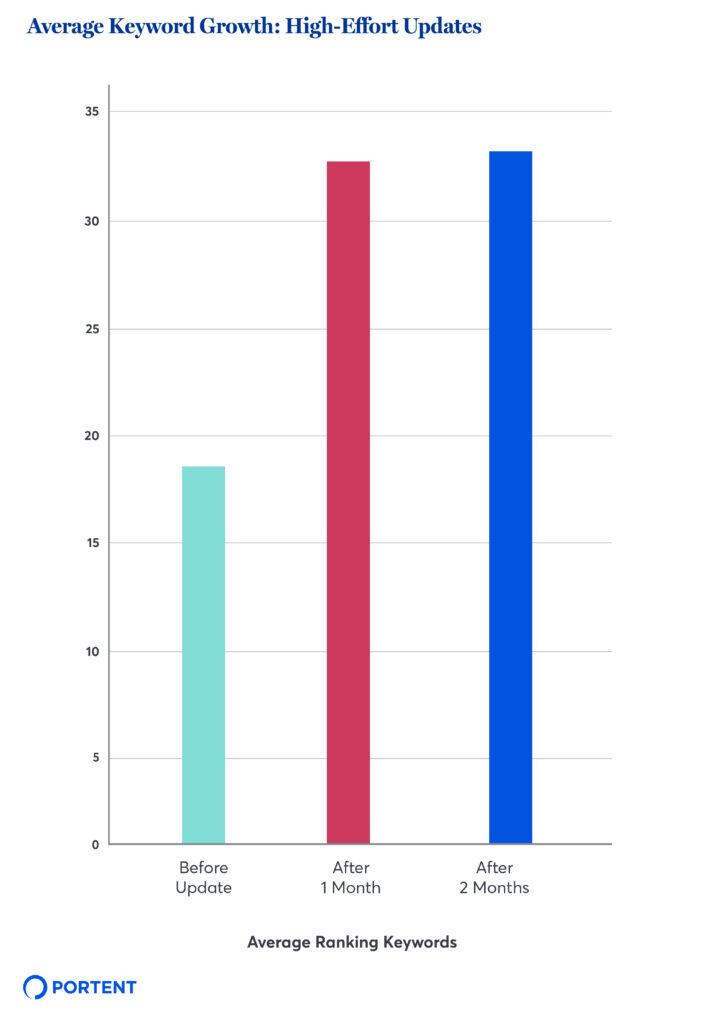
The rewritten blog posts earned an average keyword growth of 454%. One of the posts also earned a shared featured snippet, and the update group cumulatively gained 18 first-page rankings.
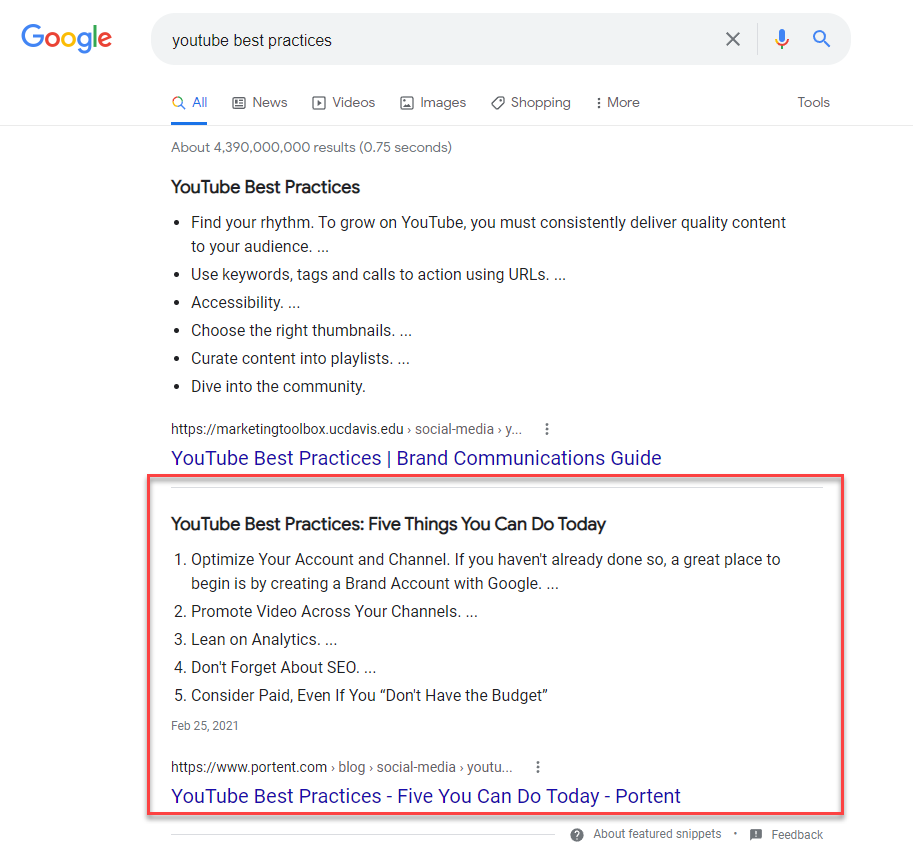
However, the results are not as impressive as they sound.
Fifteen of the 20 blog posts started with fewer than six ranking keywords. Of those 15, four posts earned no keyword rankings within two months of the published rewrite, staying at zero.
However, three of these posts netted more than 1,000% keyword growth.
- What is a Quality Score: 0 to 31 keywords
- 6 Ways to Optimize ECommerce Facebook Ads: 2 to 27 keywords
- YouTube Best Practices: 1 to 15 keywords
If you remove these high-percentage outliers, the remaining results are more humble, with an average keyword growth rate of 196%.
What fascinates me the most about the high-effort findings is how the keyword growth changed after several months passed.
Because these posts were updated as part of Portent’s regular inbound marketing strategy, I have access to significantly more data than the 40 posts I updated explicitly for this study.
The biggest shocks are two blog posts that started with no keywords and earned no keywords two months after the rewrites were published. Once I expanded the data timeline, I discovered that both articles gained a significant number of keywords four to five months after the updated versions were published.
- How to Create a Google Ads Remarketing Campaign: 0 to 131 keywords, all 131 terms gained five months post-update. The article also gained 21 keywords ranking in the first-page results.
- Google Display Ads: Specs and Best Practices: 0 to 236 keywords, 130 keywords earned four months after the update. The article also got three keywords ranking in the first-page results.
With long-term data, I also saw 13 blog posts earn more keywords than they began with and seven posts that lost keywords over time. The posts that earned and maintained first-page rankings also changed, with the final cumulative total of 40 keywords in the top-10 positions.
Result: Medium-Effort Blog Post Rewrites
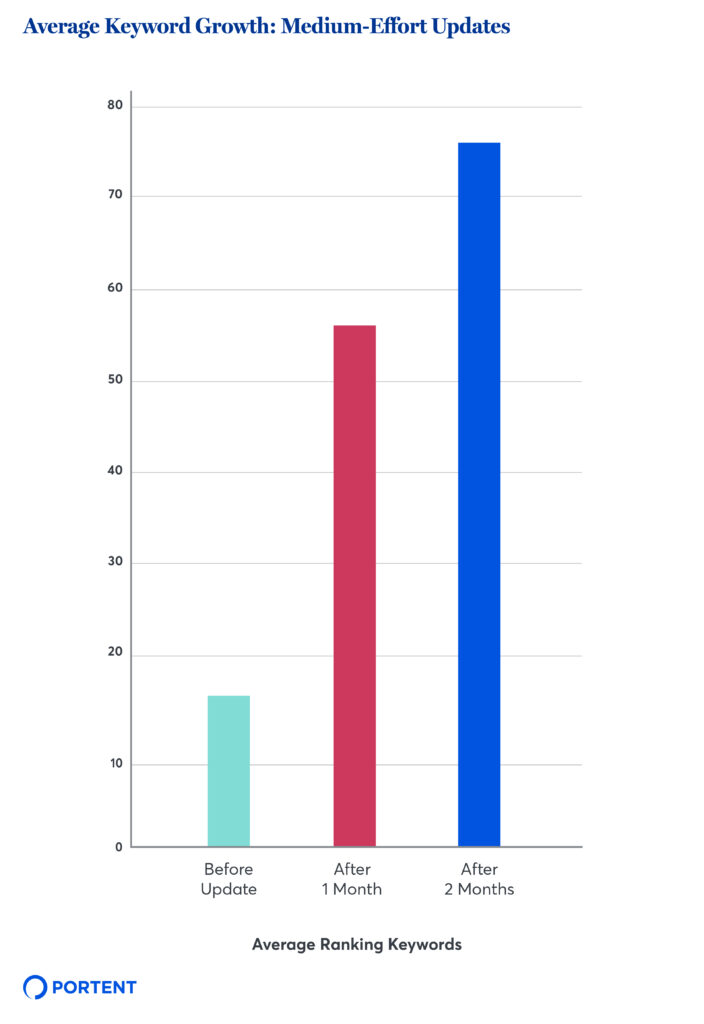
Updating the title, metadata, publish date, and introduction earned this batch of 20 blog posts an average keyword growth of 1,081%. The posts also got five featured snippets, an image pack, and 38 cumulative first-page rankings.
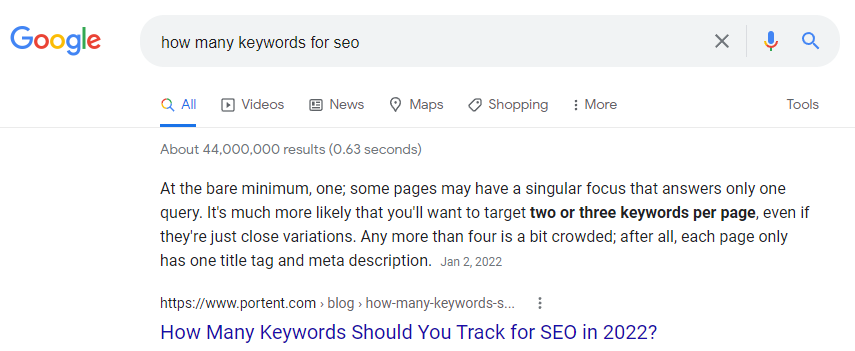
Like the full rewrite section, there are five outlier cases that skew the data.
- How to Easily Perform a Social Media Audit: 2 to 106 keywords
- How to Measure User Intent with Google Analytics: 0 to 20 keywords
- LinkedIn Advertising: How to Create a B2B Campaign: 0 to 39 keywords
- How Often Should You Perform a Content or Blog Audit: 1 to 61 keywords
- How to Develop the Best Content Marketing Strategy: 11 to 160 keywords
After removing these high-percentage outliers, the remaining pages earned an average keyword growth rate of 211%.
The results from this group are fantastic compared to the effort I put forth in updating the posts. Some updates were tiny, took 10-30 minutes, and had huge gains. Let’s look at two examples.
First up is the post How Many Keywords Should You Track for SEO in 2022. Portent first published the article on June 25, 2019. As of January 31, 2021 (the day of my updates), the post had 118 keywords, 17 first-page rankings, and two People Also Ask answers. Here are the changes I made to this post:
- Old Title (H1): How Many Keywords Should You Be Tracking?
- New Title (H1): How Many Keywords Should You Track for SEO in 2022?
- Old Title Tag: How Many Keywords Should You Be Tracking? – Portent
- New Title Tag: How Many Keywords Should You Track for SEO in 2022? | Portent
- Old Meta Description: You need to track keywords to help measure your SEO efforts, so how many do you need? Follow our simple formula to get started.
- New Meta Description: You need to identify and track keywords to help measure your SEO efforts. So, how many keywords do you need to track? Follow our simple formula to get started.
- New Publish Date: January 2, 2022.
The results for five minutes of effort are outstanding. On March 31, 2022 the blog post ranked for 448 keywords, a 279% increase, and gained five featured snippets. It did lose one first-page ranking and both People Also Ask answers, but five featured snippets are a much more valuable reward.
For the second example, let’s look at the post How to Build a Brand Voice & Tone Style Guide. Portent originally published the article on August 17, 2017. As of January 31, 2021, the post had 13 keywords and no first-page rankings. Here are the changes I made to this post:
- Old Title (H1): Why You Need a Voice and Tone Guide. Plus, 2 Exercises to Create One
- New Title (H1): How to Build a Brand Voice & Tone Style Guide
- Old Title Tag: Why You Need a Voice and Tone Guide. Plus, 2 Exercises to Create One – Portent
- New Title Tag: How to Build a Brand Voice & Tone Style Guide | Portent
- Old Meta Description: Understanding your brand’s voice and tone is crucial to connecting with your audience. Use these exercises to create a Voice and Tone Guide.
- New Meta Description: Understanding your brand’s voice and tone is crucial to authentically connect with your audience. Use these exercises to create a Voice and Tone Guide.
- New Publish Date: January 17, 2022.
I also rewrote the introduction to condense seven paragraphs into two. I encourage you to view the original version of this post via Archive.org and compare it against the updated article.
I spent about 30 minutes updating this blog post. And the results are off to a phenomenal start. On March 31, 2022 the blog post ranked for 134 keywords, a 930% increase, and earned two first-page rankings.
Result: Low-Effort Blog Post Rewrites
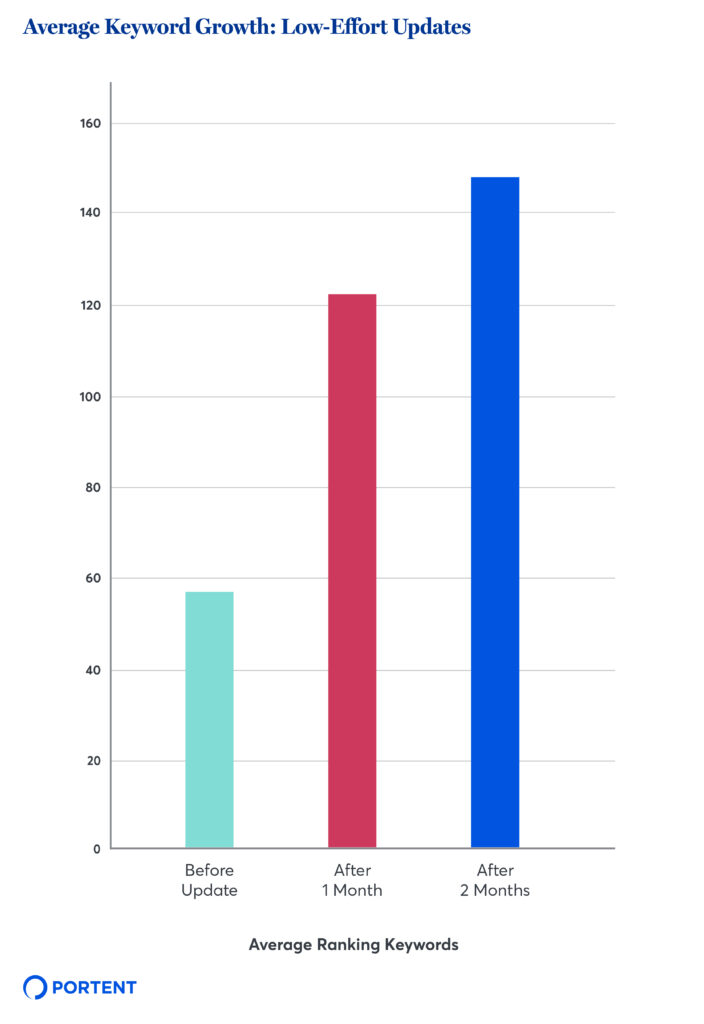
Updating the publish date earned these 20 blog posts an average keyword growth of 475%, with only two outliers. Plus, the articles also earned 45 cumulative first-page rankings, two featured snippets, and one People Also Ask answer.
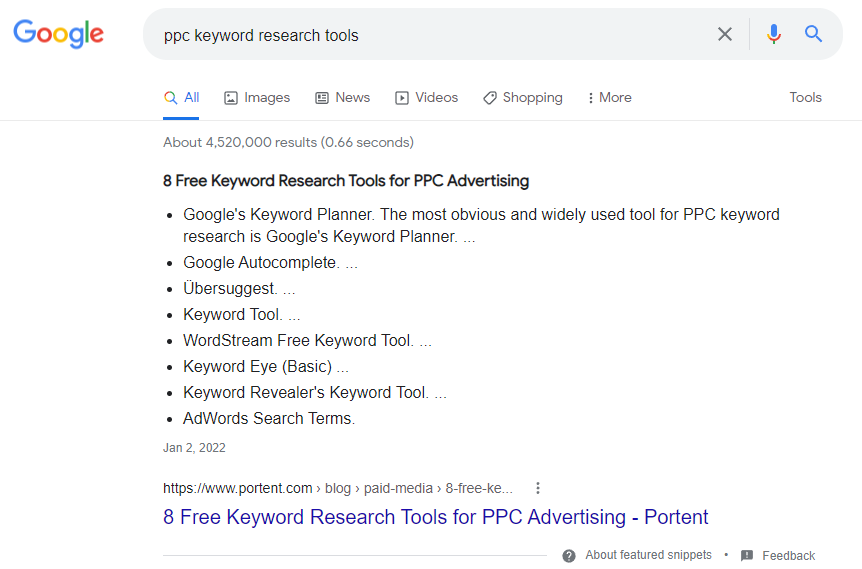
The two outliers are also less egregious than the high or medium-effort updates.
- How To Choose a Domain Name – An SEO’s Guide: 1 to 22 keywords
- SEO for Small Business – The Topics, Tactics & Tools: 1 to 47 keywords
After removing these high-percentage outliers, the remaining pages earned an average keyword growth rate of 155%.
The results from the low-effort updates are unnerving and surface two questions:
- Do users have a bias toward new content? If so, is that a reason Google’s algorithms gave new keyword rankings to blog posts with updated publish dates?
- Is Google keeping track of real updates to content?
Unfortunately, I don’t know the answer to either question.
While SERP click-through rates are often argued by SEOs to be a ranking signal (despite Google’s denial), many of the blog posts that saw keyword spikes didn’t have keywords ranking in the top 20 positions and thus get minuscule SERP clicks.
And while my suspicion is that Google’s crawlers don’t track before-and-after changes to blog posts, I don’t have any evidence to back up that idea.
What I do know is that under no reasonable circumstances should simply changing the publish date have this dramatic outcome. The information and advice in several of these blog posts is nearly a decade old, with references to extinct tools, features, companies, and marketing techniques.
On the bright side, it turns out that publish date updates are a superb way to game the algorithm and start ranking for significantly more keywords.
However, I encourage you to use this technique ethically because there is no saying what type of penalties or changes could pop up in future updates around this strategy. For all we know, Google may already be looking for large-scale abuse of this tactic.
What the Results Mean for Blog SEO and Keyword Strategy
The results of my experiment present more questions than answers about how Google’s algorithms rank refreshed blog posts. And unfortunately, I still don’t have a definitive answer to my original question: which option is best?
From an effort-to-reward perspective, the medium-effort blog posts performed the best. But the biggest lesson from this study is that literally any type of update can improve rankings — even the laziest strategies I could fathom.
With that concept in mind, here are three takeaways that are worth implementing on your blog.
1. Your Blog Posts Might Need a Visible Publish Date
The low-effort cluster demonstrates that Google’s algorithms favor newer content more than older articles.
I can’t definitively say that your blog post needs a crawlable publish date because I didn’t test removing publish dates as a control. However, the results allude that either search engines or users care a lot about blog article timeliness, which aligns with the Query Deserves Freshness ranking factor.
Having a visible publish date is the easiest way of presenting timeliness, so I believe it’s a useful feature for any blog.
2. Refresh Your Blog Post Title, Metadata, and Publish Date Annually
The results from solely updating a blog post’s title (H1), metadata, and publish date astonished me.
Although my sample size, eight posts, doesn’t reach statistical significance, the average keyword growth after two months is 761%.
The most significant improvement came from the post How to Easily Perform a Social Media Audit in 2022, which started with two keywords and ended with 106, a 5,200% increase in ranking keywords.
Consequently, if you have valuable blog content and you want to maintain organic performance, make sure you update the title, metadata, and publish date at least annually. If you have seasonal-specific content, I’d update that blog post two months before the season starts.
3. Use the Current Year in Title Tags Whenever Appropriate
In the medium-effort update group, I added “2022” to 11 of the titles and title tags. Nine of those pages saw an average keyword growth of 1,665%. Of the remaining two posts, one had no change and the other decreased by 33%.
Of those eleven blog posts, the smallest keyword improvement was 75% (98 original keywords vs. 172 keywords post-update) and the largest improvement was 6,000% (1 original keyword vs. 61 keywords post-update).
None of the blog posts are newsworthy or time-sensitive, and I never modernized the information within posts. From what I can tell, Google or users care a lot about the appearance of timeliness rather than verifying a post has up-to-date or accurate information.
For example, one blog post, How to Develop the Best Content Marketing Strategy in 2022, gained 1,354% more keywords in two months simply by adding 2022 to the title and title tag, rewriting the introduction, and updating the publish date.
Where I Stand on Content Updates
I’m still a staunch supporter of updating old content, especially now that my experiment uncovers it’s hard to lose when playing update roulette.
However, I have a few best-practice guidelines that you should follow to ensure your blog posts are valuable for you and your readers.
Define Your Goals
If you’re going to update old blog content (and you should), make sure you define your marketing objectives first. Here are a few examples of goals I consider when rewriting blog content.
1. What keyword strategy can you employ?
Did I miss a topic if a blog post isn’t ranking for what I want? Did I choose the wrong keywords? Are my title and metadata not using the proper phases?
Are you trying to help your team better understand a new or existing user? Are you trying to gather and distill a bunch of user research into a digestible format?
2. What do you hope the user does?
You need a clear, measurable concept of what success looks like for your project and how user interaction affects that success.
Knowing what you hope users will do establishes project context and helps focus your user research activities.
Provide Value for Readers
This study goes against one of my core ethos for content strategy and marketing: everything I do must provide value for users.
I updated 40 blog posts to trick Google’s algorithm into believing the content is new and useful, even when some posts were a decade out of date. And it worked — arguably too well.
The get-keywords-quick scheme I orchestrated is disingenuous to Portent’s readers. And if you follow my exact tactics, you’ll be disingenuous to your readers, too.
On the bright side, the results confirmed the importance of frequent blog audits to spot stagnant posts and keep your content fresh. Google rewards fresh content, especially when you support a new publish date and metadata with meaningful content updates.
So, instead of performing mass, low-effort updates to your blog content, I encourage you to find useful ways to provide new value to readers. Follow the proper E-A-T rules whenever possible. Give your readers and search engines a genuine reason to appreciate your blog posts.
The post Study: How Blog Post Updates Affect Keyword Growth in 2022 appeared first on Portent.

